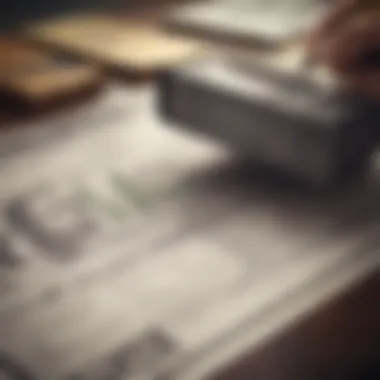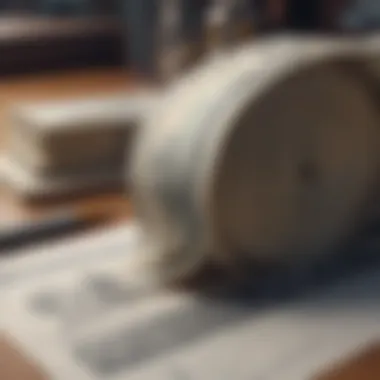Tracing a Money Order: A Comprehensive Guide


Intro
Tracing a money order can often feel like trying to find a needle in a haystack. Money orders are a popular payment method, providing a sense of security for the sender and the recipient. They aren't just any old piece of paper; they represent a financial commitment, much like cash in hand. The need to trace a money order can arise from various situations, whether it's confirming the recipient received it or tracking it for potential loss or theft. In this piece, we will unpack the layers of this process, shining a light on the importance of money orders and guiding you through the tracing steps systematically.
Understanding how to navigate this financial instrument is crucial, not just for personal transactions but also for professionals in finance who deal with these scenarios regularly. The stakes can be high, and knowing the ropes can save one from a world of headaches down the line.
Foreword to Money Orders
Understanding money orders is crucial in today’s financial landscape. They’re more than just paper with numbers; they serve specific roles in various transactions. Anyone looking to trace a money order must first appreciate what it signifies. Money orders are widely accepted and act as a secure way to transfer funds without requiring a bank account. This acceptance makes them invaluable, especially in situations where cash is impractical, or personal checks are not trusted.
Definition and Purpose
A money order is, at its core, a payment instrument. It’s similar to a check but comes with distinct advantages, primarily around safety. When you obtain a money order, the amount is prepaid, meaning those funds are guaranteed, unlike personal checks that might bounce. People use money orders for numerous reasons:
- Paying bills: This can be effective for situations where electronic payments are not an option.
- Sending money: They're often utilized to send money to family or friends, especially in contexts where a bank transfer is not feasible.
- Purchases: Many vendors accept them, providing flexibility for shoppers.
Moreover, money orders serve as a good alternative for people without bank accounts or those wishing to avoid sharing sensitive information.
History and Evolution
The roots of money orders can be traced back many decades, with their origins in the practical needs of transferring funds securely. The Western Union company is known for its early involvement in the money order market, setting the stage for widespread adoption.
As society evolved, so did the ways of handling personal finance. Money orders gained prominence especially during times when not everyone had access to banking services.
In modern times, they've been enhanced by technology. Digital money orders have emerged, allowing users to send money online. Such transformations reflect a blend of tradition and innovation, making money orders relevant both in the past and present.
In summary, knowing the basics of money orders—their definition and purpose—sets the groundwork for tracing them effectively. Whether it’s a lost order or concerns over potential fraud, understanding these financial tools enhances one’s ability to navigate the tracing process.
Reasons for Tracing a Money Order
Tracing a money order can feel like trying to find a needle in a haystack, but it’s often a necessary step to ensure that your funds are secure and your transactions are legitimate. Understanding why you might need to trace a money order helps shed light on the overall process and prepares you for the steps ahead. Three main reasons often drive individuals to embark on this tracing journey.
Lost or Misplaced Orders
It’s all too easy for a money order to get lost in the shuffle of life. Perhaps it slipped between the cushions of your couch, or it vanished into thin air during a move. When a money order is lost, the situation can become quite stressful. Without a clear path to trace the money order, it can feel like money gone down a black hole.
To tackle this issue, having the original receipt is crucial. The receipt is your golden ticket; it contains vital information like the money order number, amount, and the issuer's details. Armed with these specifics, you can reach out to the issuing institution to investigate the situation. They usually have procedures in place to help locate lost orders, although the process can vary from one institution to another.
"Always keep a record of any financial transactions; it saves trouble later."
Potential Fraudulent Activity


The world of money orders can have its shady corners, and potential fraud is a serious concern. Imagine sending a money order only to find out later that the recipient is a scammer. Or, perhaps you received a money order that seems suspicious. In these cases, tracing the money order becomes not just a precaution, but a necessity.
When tracing for suspected fraud, it’s important to act swiftly. Contact the issuer immediately with all your details. They can provide guidance on whether the money order has been tampered with or whether there’s anything suspicious flagged in their system. Furthermore, reporting suspected fraud can help protect others from falling victim to similar scams.
Confirmation of Receipt
In financial transactions, it’s always wise to get confirmation. Whether you’ve sent a money order to a friend or paid a vendor, knowing that the recipient has received the funds is vital. Tracing a money order in this context becomes essential to ensure that everything is above board.
This might involve a bit of detective work. Start by checking with both the recipient and the issuing institution to verify the transaction. If there’s been a delay or issue on the recipient’s end, tracing the order provides clarity. Plus, if there’s proof of payment, it can save you from potential disputes down the line.
Overall, these reasons highlight the practical significance of learning how to trace a money order. Awareness of the potential challenges and knowing the steps to take can provide peace of mind and security in financial dealings.
Preparing to Trace a Money Order
Tracing a money order can feel like hunting for a needle in a haystack, especially if it’s misplaced or if there are concerns about fraud. Thus, the preparation stage becomes critical. Before diving into the tracing process, it's essential to gather all necessary information and identify the issuer properly. This preparatory phase ensures that you are equipped with the right details, which can save a world of trouble down the line.
Gathering Necessary Information
Before you can even think about calling the issuer or using an online tracking tool, you need to have your ducks in a row. Here are the specifics to collect:
Money Order Number
The money order number is a unique identifier, akin to a fingerprint, for each order. This number acts as your primary reference point and is critical in the tracking process. It provides the issuer with necessary info about where and when the money order was issued. Without this number, tracing becomes nearly impossible.
- Key Characteristic: Uniqueness. The number is exclusive to each order, which means it links directly to a specific transaction.
- Benefits: It helps streamline communication with the issuer, enabling quick status inquiries and preventing mix-ups with similar orders.
- Unique Feature: Money order numbers are often printed directly onto the order, making them easy to spot.
- Advantages/Disadvantages: One downside is that if you lose the physical order and can’t recall the number, it complicates the tracing process, leading to delays.
Issuer Information
This refers to the financial institution or entity that issued the money order. Knowing who the issuer is crucial, as each has its own policies and procedures for tracing orders. If you're unsure of the issuer, your tracking efforts may spiral into a frustrating maze.
- Key Characteristic: Institutional Variety. Issuers can range from banks and credit unions to postal services.
- Benefits: Understanding the specific issuer can help you identify the correct channels for tracing and expedite the service.
- Unique Feature: Each issuer may provide different tracking tools and guidance for lost orders.
- Advantages/Disadvantages: However, if you've dealt with multiple issuers or have an outdated order, locating this information can be challenging, potentially leaving you high and dry.
Purchase Details
Having the details of the purchase adds another layer of context to your tracing efforts. This includes the date of purchase, the amount, and the recipient's information. It’s the kind of backdrop that complements your main act, making the understanding of your case clearer.
- Key Characteristic: Specificity. Finer details can jog your memory and aid the issuer in locating your money order.
- Benefits: Clear purchase details can eliminate confusion and facilitate detailed inquiries.
- Unique Feature: These transactions are often recorded in your bank statement or in the receipt provided at the time of purchase.
- Advantages/Disadvantages: However, if you didn't keep notes or documents about your transaction, those details could become lost, complicating the tracing effort.
Identifying the Issuer
Identifying the right issuer isn't just about knowing the name; it often means sleuthing for the right contact method. Each issuer may have different requirements or forms necessary to proceed, so it's essential to do your homework. Understanding the nuances of each institution can help avoid a misstep that throws a wrench in the tracing process.


Tracing the Money Order Process
Tracing a money order is a pivotal action that serves as a safeguard in financial exchanges. When one finds oneself navigating the financial maze, understanding how to trace a money order can alleviate anxiety and prevent losses. Every transaction involving money exchange, especially with money orders, warrants attention because they often operate outside the typical banking systems. Hence, knowing the tracing process empowers individuals to regain control over their finances and ensures peace of mind in uncertain situations.
Contacting the Issuing Institution
The first step in tracing a money order is usually to reach out to the institution that issued it. This is crucial because the issuing authority possesses all records related to the transactions. To initiate this process, have in hand the money order number, details of its purchase, and any other pertinent information. This can streamline communication and make the process more efficient.
By establishing clear communication with the issuer, one can often expect quicker resolution and more accurate info.
When contacting the issuer, one should be prepared to communicate in an organized manner. Details like the date of purchase, the amount, and the recipient can paint a clearer picture for the representative on the other end. Moreover, keep in mind that response times may vary. Warm patience often yields the best results, as backlogs and system checks on their side could slow things down.
Using Online Tracking Tools
In this digital age, many money order issuers provide online tracking tools that expedite the tracing process. Accessing these tools is often as simple as entering your money order number on the issuer's website. This feature not only offers real-time updates, but also empowers users with the ability to track their order from the comfort of home.
However, while this feature is user-friendly, it’s essential to ensure that your internet connection and device are secure. Cybersecurity should not be overlooked when accessing sensitive financial info. Always log in through the official sites to mitigate any chances of phishing schemes or data breaches.
Additionally, it’s worth noting that not all issuers have the same level of tracking capability. Some may provide more detailed insights compared to others. Take the time to familiarize yourself with these tools, and don’t hesitate to perform further online research to better understand their functionalities, if needed.
Filing a Claim for Lost Money Orders
If tracing the money order leads to a dead end, filing a claim becomes the next logical step. This proactive measure is imperative in situations where the money order is truly lost. Most issuers have specific protocols to file a claim, often requiring a variety of documentation. This may include proof of purchase, the money order number, and sometimes, a sworn statement that you haven’t received the funds.
In estimating the timeline for a claim case to be processed, patience is key. It typically takes a few weeks, sometimes longer, depending on the issuer and complexity of the situation. As you tread through this process, staying organized and keeping all communication records is vital. Having everything in one place can always facilitate future interactions with the institution.
Ultimately, whether you’re trying to chase down missing funds, equipped with online tracking tools, or navigating the claims process, understanding the ins and outs of tracing a money order is indispensable. By knowing what steps to take, you can assertively address issues as they arise, ensuring efficiency and success in your financial dealings.
Challenges in Tracing Money Orders
Tracing a money order is not as straightforward as it might seem. This section discusses the various challenges that can surface during the tracing process, which can often complicate what should be an ordinary task. By identifying and understanding these obstacles, readers can prepare themselves better for handling the issues that might arise when trying to locate a money order. Let's dive into the specific challenges:
Communication Barriers
One prevalent issue people face when tracing a money order is communication barriers. These barriers can manifest in several ways, such as language differences or miscommunication with representatives from the issuing institution. When dealing with financial matters, clarity is vital. A misunderstanding due to a language gap can lead to delays or even further complications. It's not uncommon for someone to feel lost in the murky waters of jargon-heavy conversations with bank representatives.
Moreover, each financial institution may have different protocols and levels of service. Some might not provide comprehensive support, leaving customers frustrated. Even if they speak the same language, the nuances in terminology can sometimes trip up communication. Having a clear list of questions prepared can help one navigate these conversations more effectively.
"Understanding the language of financial institutions is akin to learning a new dialect—without it, you might find yourself knee-deep in confusion."
Time Constraints


Another challenge that often hampers the tracing process is time constraints. Many individuals operate under tight schedules, making it difficult to devote the necessary time to resolving issues with money orders. From waiting on hold for customer service to having to fill out extensive paperwork, the tracing process can consume a significant chunk of your day.
Additionally, urgent situations sometimes necessitate a swift resolution. For instance, if a money order was sent to pay a bill and it’s been lost, the buyer needs to act fast to avoid late fees or potential service disconnections. Being prepared with all relevant information can speed up the process. Nonetheless, time pressure often creates an environment where mistakes can happen, further complicating an already stressful endeavor.
Potential Fees and Costs
Finally, potential fees and costs present another obstacle when tracing a money order. Depending on the issuing institution, there may be charges involved in obtaining a replacement or initiating a trace request. Hidden fees can catch many off-guard, leading to unexpected expenses. Unfortunately, not every service is transparent about their pricing structures.
If you’re contemplating tracing a money order, it’s essential to inquire upfront about any potential costs involved. You may even want to compare the expenses associated with different institutions to find the most economically sensible option. Remember, extra costs can add up quickly and may offset any financial benefit you were hoping to gain from the money order in the first place.
Preventative Measures
Taking proactive steps when dealing with money orders can save a world of trouble down the line. After all, it’s easier to prevent a problem than to solve one. The importance of preventative measures cannot be overstated. Not only do they protect your financial interests, but they also help in avoiding potential issues that could arise from lost or misplaced money orders.
Safeguarding Money Orders
The first line of defense against complications is to safeguard your money orders. This entails not just physical safety but also ensuring that you have the information needed to trace them if they go missing.
- Store Them Securely: Always keep money orders in a secure location. A locked drawer or a safe can do wonders in keeping them away from prying eyes.
- Avoid Leaving Them Unattended: If you are in a public place or even at home, make it a point to keep money orders with you. Leaving them lying around increases the chance they might get lost or even stolen.
- Use a Tracking System: When you purchase a money order, keep a personal tracking system. Note down the money order number, issuer, and amount paid on a dedicated sheet or app. This can act as your reference point if you need to trace the order later.
- Consider Digital Options: If possible, consider using digital money orders or electronic transfers. They often come with tracing capabilities built right in, reducing the likelihood of losing the transaction.
By taking these precautionary steps, you can shield yourself from the headaches that a lost or misplaced money order can bring.
Best Practices for Record Keeping
Alongside physical security, effective record keeping plays a pivotal role in managing money orders. One way to ensure a smooth tracing process is to maintain thorough and organized records.
- Document Every Transaction: Keep a ledger that includes all pertinent details such as purchase date, amount, and recipient's information.
- Utilize Technology: Use spreadsheets or dedicated financial apps to track your money orders. This will not only keep everything organized but also provide you with quick access to the information when needed.
- Periodically Review Records: Regularly check your records to ensure that they are up-to-date. Cross-check them with your bank statements or any receipts you might have kept.
- File and Preserve: Store all related documents, like receipts and copies of the money orders themselves, in a single location. This will make the information readily available should any issues arise.
In essence, the key to successfully tracing a money order lies in your ability to prevent losses before they happen. By safeguarding money orders and embracing best practices for record keeping, you put yourself in the best position to handle any financial uncertainties.
"An ounce of prevention is worth a pound of cure." This age-old saying rings particularly true when dealing with financial transactions.
Finale
The process of tracing a money order is more than just a task; it’s a crucial component in the management of personal finances, particularly for investors, financial advisors, and educators. In an era where digital transactions dominate, recognizing the value of such traditional forms of payment is paramount. This article sheds light on the necessary steps and considerations one must undertake to effectively navigate this process.
Summary of Key Points
Tracing a money order involves a series of systematic steps that require meticulous attention to detail. Here are the key points highlighted throughout this guide:
- Understanding the purpose of money orders: These instruments serve as secure forms of payment and can be critical in various financial transactions.
- Reasons for tracing: Often stemming from lost or misplaced orders or concerns regarding potential fraud, the need to trace a money order cannot be underestimated.
- Preparation is key: Collecting all necessary information such as the money order number and issuer details is essential for successful tracing.
- Utilizing available resources: Whether it's contacting the issuing institution or leveraging online tracking tools, knowing how to tap into these resources can make a world of difference.
- Challenges faced: From communication barriers to potential fees, understanding these challenges can help individuals be better equipped.
- Preventive steps: Taking proactive measures, such as safeguarding money orders and adhering to best practices for record keeping, can mitigate future tracing needs.
Final Thoughts on Money Orders
Money orders may seem old-fashioned in our fast-paced digital landscape, but they are far from obsolete. For investors and financial professionals, understanding how to trace a money order not only ensures that funds are secure but also establishes trust in financial transactions. When dealing with money orders, being prepared is half the battle. By recognizing the importance of these tools and how to manage them, individuals can navigate their finance with added confidence. After all, it's not just about tracing; it's about understandng all the nuances that come with handling money effectively.
In summary, tracing a money order is an essential skill that blends practical knowledge with strategic foresight, equipping professionals to make informed decisions in their financial journeys.



